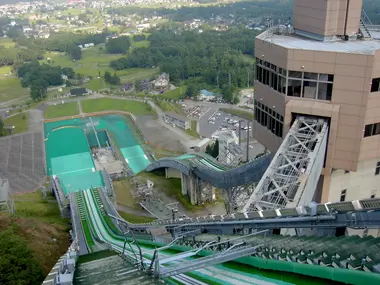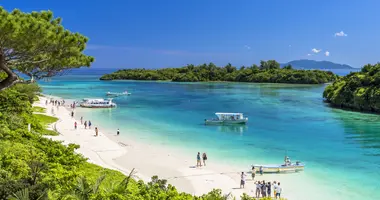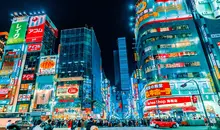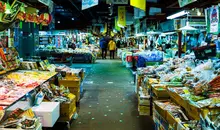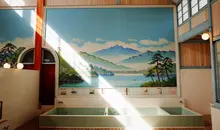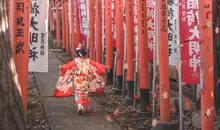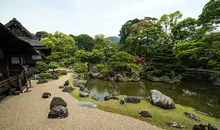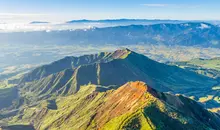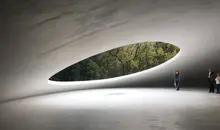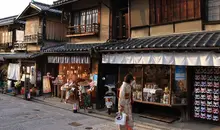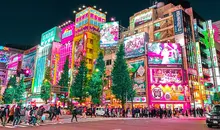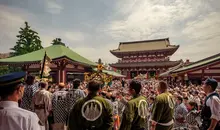Hakuba: a fascinating combination of star-studded gastronomy and winter sports paradise in Japan
- Published on : 04/05/2018
- by : J.L.
- Youtube
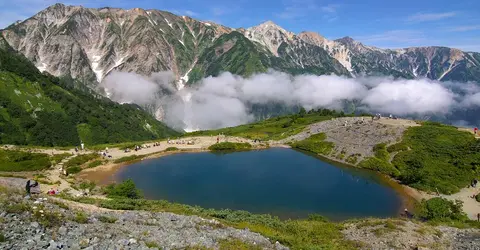
Happo Ike
Flickr Tsuda
Mountains of the four seasons
Nestled in the heart of the Japanese Alps in Nagano Prefecture, Hakuba (白馬村, meaning "white horse") is a destination that fascinates with its versatility and richness. This mountain village attracts visitors from all over the world as much for its legendary ski resorts as for its breathtaking scenery. With a surface area of 189.36 km² and a population of around 9,000, Hakuba combines centuries-old Japanese traditions with a modern, world-class infrastructure. From the snow-capped peaks that hosted the 1998 Winter Olympics to the Michelin-starred Parisian restaurants that bear its name, Hakuba embodies Japanese excellence in all its forms.
The Hakuba restaurant in Paris: a Michelin-starred Japanese gastronomic experience
In the heart of Paris, the Hakuba restaurant represents a refined gastronomic immersion in ritualized Japan. Located on the first floor of Cheval Blanc Paris, this MICHELIN-starred establishment is the fruit of an exceptional collaboration between several top chefs. Under the leadership of Arnaud Donckele, Hakuba was born of a four-hands collaboration with chef Takuya Watanabe, originally from the island of Hokkaido, and a sweet conversation with pastry chef Maxime Frédéric.
The restaurant offers Omakase menus - literally meaning "leave it to the chef" - which reflect Takuya Watanabe's desire to offer the best of Japanese gastronomy in its purest expression. The dishes, composed mainly of seafood, raw and cooked fish, soy and gluten, embody the very essence of traditional Japanese cuisine. Arnaud Donckele brings his French vision to the table, with his culture of sauces, seeking to enhance flavors to punctuate the culinary experience through broths, sushi, caramelized fish and other refined compositions.
The interior architecture interprets a contemporary vision of Japanese tradition. At the entrance, a Tsukubai fountain in stone and bamboo diffuses the soothing murmur of flowing water. Dark woods such as black walnut symbolically recall the Japanese forest, while a play of focal lights brings texture and relief to the dishes, evoking the sun's rays filtering through a clearing. The restaurant features three counters, allowing chefs to move around and create a privileged relationship with guests.
Hakuba: location and characteristics of the Japanese village
Hakuba-mura (白馬村) is a village in the Kitaazumi district of Nagano prefecture, in the heart of the Northern Japanese Alps. Its name, which literally means "white horse", refers to the shapes of the snowdrifts visible from the village in spring on Mount Shirouma. Surrounded by picturesque valleys that receive over 11 meters of snow annually, Hakuba stretches for almost 30 kilometers along the eponymous mountain range.
What makes Hakuba particularly interesting from a geological point of view is its position on the Itoigawa-Shizuoka tectonic line, which corresponds to the boundary between western Japan (the Eurasian plate including the Northern Japanese Alps massif) and eastern Japan (the Fossa Magna, then the North American plate). Until around 12 million years ago, these two parts originally constituted two distinct islands. This explains why Hakuba's thermal springs are salty, containing seawater that was retained in the earth's crust prior to the formation of the Fossa Magna.
The Hakuba Valley lies in the north-east of Nagano Prefecture, surrounded by majestic peaks covered in snow for much of the year. At an average altitude of 800 meters, this village offers a typical mountain climate with four distinct seasons, each offering its own set of activities and spectacular scenery. In 2023, Hakuba was awarded the prestigious "Best Tourist Villages" label by the World Tourism Organization, recognizing its commitment to sustainable and authentic tourism.
Hakuba ski resorts: a world-renowned Olympic venue
Hakuba really came into its own at the 1998 Nagano Winter Olympics, when it hosted the Alpine skiing speed events (downhill and super-G), ski jumping and Nordic combined. It was here that French skier Jean-Luc Crétier won the Olympic title in the downhill event on February 13, 1998. The two large ski jumps (90 and 120 meters) used at the Games are still here, bearing witness to this Olympic heritage.
Today, the Hakuba Valley has become one of Japan's most important winter sports destinations, dubbed "Japan's outdoor mecca". It is home to an impressive ski area with 10 main resorts: Jiigatake, Kashimayari, Hakuba Sanosaka, Hakuba Goryu, Hakuba47 Winter Sports Park, Hakuba Happo-one, Hakuba Iwatake Snow Field, Tsugaike Kogen, Hakuba Norikura Onsen and Hakuba Cortina. These resorts collectively offer over 200 runs served by 146 lifts, suitable for all levels of skier, from beginner to expert.
Of these, Hakuba Happo-one is the largest and most emblematic, with 13 runs and an impressive vertical drop of 1,071 meters. Its longest run stretches for 8 kilometers and, on a clear day, offers a spectacular alpine panorama from the summit. Each resort has its own special features: the northern slopes of Hakuba47 offer some of the best snow in the region, while the untouched powder of Hakuba Cortina is very popular with experienced skiers.
A major benefit for visitors is the Hakuba Valley Ticket, an all-inclusive pass giving access to eight of the ski resorts. During its period of validity, this pass allows use of the lifts in the various resorts and also gives free access to the shuttle buses that serve the valley. International Epic Pass holders can also benefit from a free five-day ski pass for use in the valley's resorts.
Summer activities and tourism in Hakuba
While Hakuba is world-renowned for its winter sports, it transforms into a veritable paradise for outdoor enthusias ts in the warmer months. Its altitude of 800 meters offers a welcome breath of fresh air away from the stifling heat of Japan's big cities in summer. The spectacular alpine scenery, clean air and wealth of activities available make Hakuba a popular year-round destination.
Hiking is Hakuba's main summer activity. Numerous trails allow you to explore the surrounding mountains, including several remarkable itineraries:
- Mount Hakuba (Shirouma): this hike takes you into the "valley of eternal snows", where even in summer you can walk on glaciers.
- Mount Karamatsu: renowned for its exceptional scenery and 360-degree panorama at the summit.
- Happo Pond: accessible via a long wooden path, it offers the magical spectacle of snow-capped mountains reflected in its calm waters.

Summer hiking on Mount Hakuba
Wikimedia Commons
It's important to note that for all these hikes, proper equipment is required, including clothing adapted to the sudden weather changes specific to the mountains. In addition, a safety procedure requires hikers to leave a route sheet (Tozan Keikakusho) in a dedicated box at the trailhead or in a mountain hut for high-altitude excursions.
In addition to hiking, Hakuba offers a multitude of varied and attractive summer activities:
- Hot-air balloon flights over the mountain range
- Paragliding for the more adventurous
- Canoeing and rafting on the torrents
- Rock climbing
- Mountain biking on the many mountain trails
Evergreen Outdoor offers a variety of activities in summer, including mountain biking, rafting, kayaking and even tree climbing.
For camping enthusiasts, the summer months are ideal for enjoying the great outdoors at Hakuba. Sleeping under the stars, with the heavens above you, offers a memorable experience in the heart of Japanese nature.
Accommodation and nightlife in Hakuba Valley
Hakuba Valley offers a diverse range of accommodation to suit all budgets and travel styles. With almost 600 establishments spread across the region, options range from luxurious mountain hotels to traditional Japanese ryokans, friendly guesthouses, apartments and chalets. This diversity reflects the evolution of Hakuba as a tourist destination, from the 1970s and 80s, when it catered mainly for Japanese visitors, to the present day, when it has become a popular international destination.
Among the most popular areas to stay are:
- Happo: located at the foot of the Hakuba Happo-one resort, this central area offers an ideal location just a short walk from the slopes. Its many facilities make it a very convenient base. English-language ski and snowboard lessons are available, as well as a day-care service. The village is lively until late, with restaurants, bars and stores.
- Echoland: this neighboring area, although requiring the use of shuttles to access the slopes, often offers more economical accommodation than Happo. It's a popular spot for young visitors, renowned for its lively nightlife with numerous bars, clubs and pubs.
- Wadano: a quieter, wooded area with quality accommodation.
A major attraction of Hakuba is the many onsen (hot springs) in the area. There are five main hot springs in the village of Hakuba itself, and a dozen or so establishments offer these traditional Japanese baths at modest prices (between 600 and 800 yen a visit). These onsen offer total relaxation after a day of activity, warming the body and soothing the mind.
The Hakuba Happo region is particularly renowned for its hot springs, with 75 lodgings offering their own baths, five onsen open to outside visitors and three public foot baths. The water in this region has unique properties, being highly alkaline with a pH above 11, giving it natural exfoliating virtues and anti-aging properties thanks to the hydrogen present.
After a day on the slopes or hiking, Hakuba's nightlife comes alive. Thanks to its long tradition of international visitors, the valley offers a cosmopolitan atmosphere while preserving its authentic Japanese charm. There are pubs serving craft beer, izakaya (traditional Japanese restaurants), ramen bars and restaurants serving a variety of cuisines from around the world. At certain times of the year, a night bus shuttle runs between the resorts and the Happo area, making it easy to enjoy a night out.
How to get to Hakuba and around the region
Hakuba is easily accessible from major Japanese cities, which partly explains its popularity with domestic and international tourists. Several transport options are available depending on your point of departure:
From Tokyo:
- The fastest option is to take the Hokuriku shinkansen (high-speed train) from Tokyo station to Nagano (approx. 1h30), then an express bus to Hakuba (approx. 1h). The total journey takes at least 2h40.
- Alternatively, you can take the "Super Azusa" limited express train on the Chuo line from Shinjuku to Matsumoto, then continue on the Oito line to Hakuba station. This journey takes around 3h40.
- Direct buses also connect Tokyo to Hakuba, notably from Haneda and Narita airports.
From other cities :
- From Nagoya: Shinano limited express train to Hakuba station (minimum 3h34).
- From Osaka: JR Thunderbird limited express train to Kanazawa station, then Hokuriku shinkansen to Nagano and bus to Hakuba.
- Long-distance buses also connect the region from Chubu International Airport (near Nagoya) and from Osaka.
Once here, getting around the Hakuba Valley is relatively straightforward thanks to an efficient network of free shuttle buses linking the various ski resorts and surrounding villages. During the winter season, this transport system is particularly developed to facilitate access to the various resorts. Holders of the Hakuba Valley Ticket (common lift pass) can use these shuttles free of charge, on three main routes:
- From Jiigatake Snow Resort to Happo-one Nakiyama Slope
- Goryu Escal Plaza to Tsugaike Kogen Snow Resort
- From Hakuba Happo bus station to Hakuba Cortina
Many resorts also offer their own shuttle service, and bus routes and timetables are available from the tourist office. At certain fixed times of the year, an evening shuttle bus runs between the resorts and the town center, making it easy to get out and about in the evening.
Hakuba events and local culture
Hakuba has a rich cultural history that is perpetuated through various traditions and events throughout the year. One of the most fascinating aspects of its heritage is linked to the "Salt Road" (Chikuni-kaido), an ancient 120-kilometer trade route that passed through Hakuba, linking Itoigawa on the Sea of Japan coast, where salt was harvested, to Matsumoto.
This historic route is celebrated today at the Shio no michi matsuri (Salt Road Festival), a major cultural event held every year during Golden Week, on May 3, 4 and 5. During these festivities, the people of Hakuba don sumptuous traditional costumes reminiscent of travelers from bygone eras, and retrace part of this historic route at the foot of the Alps. With its ancient temples and venerable stone statues, this family spectacle offers an immersion in the region's past and is one of the valley's biggest celebrations.
This trade route also influenced local gastronomy. With the salt and seafood that passed through the Hakuba Valley, traditional dishes were created, such as pickled seasonal vegetables, and foods such as salt squid (shio maru ika) and dried seaweed (ego) have become local specialties.
In addition to the Salt Route Festival, each ski resort organizes various events throughout the winter. Among the most notable are
- Happo-one New Year's Eve party
- Happo-one Fire Festival in February
- Hakuba47's Ice Sculpture Festival in February
Hakuba has also developed its own culinary specialties that blend traditional Japanese influences with international inspirations, reflecting the cosmopolitan history of this destination. For example, "galette Hakuba", created by chef Masanori Hara of Petit Hotel Enchante, has become an emblematic dish of the region. Inspired by French cuisine but adapted to local tastes and ingredients, notably buckwheat flour (soba), this specialty is now served in over 40 restaurants in the region.
Other local products are the pride of Hakuba, such as hozuki fruit (a type of Japanese winter cherry) grown by local farmers, and artisanal soba noodles. The region is also renowned for its quality pork and dairy products. This fusion of age-old traditions and culinary innovation perfectly reflects Hakuba's identity: a village deeply rooted in its Japanese heritage yet open to international influences.
Whether you're a winter sports enthusiast, a hiking enthusiast, a gourmet food lover or simply looking to immerse yourself in authentic Japanese culture, Hakuba offers a complete experience that will satisfy all your expectations. This fascinating destination between the Japanese Alps and age-old traditions is waiting to be discovered, whatever the season, for Our tour in the heart of the Japanese Alps.
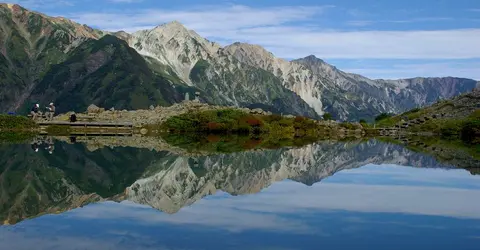
Happo ike, the famous reflection of the mountains in the lake
Flickr Tsuda
Address, timetable & access
Address
Timetable
From Tokyo by shinkansen to Nagano, then by bus in 50min. to Hakuba. From Shinjuku by Express train by Chûô line 'Super Azusa' to Matsumoto, then by Ôito line to Hakuba station, 3h40min.Access
From Tokyo by shinkansen to Nagano, then by bus to Hakuba, 50min.
From Shinjuku by express train on the Chûô 'Super Azusa' line to Matsumoto, then on the Ôito line to Hakuba station, 3h40min.
